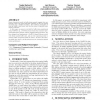Free Online Productivity Tools
i2Speak
i2Symbol
i2OCR
iTex2Img
iWeb2Print
iWeb2Shot
i2Type
iPdf2Split
iPdf2Merge
i2Bopomofo
i2Arabic
i2Style
i2Image
i2PDF
iLatex2Rtf
Sci2ools
ANCS
2007
ACM
2007
ACM
Experimenting with buffer sizes in routers
Recent theoretical results in buffer sizing research suggest that core Internet routers can achieve high link utilization, if they are capable of storing only a handful of packets. The underlying assumption is that the traffic is non-bursty, and that the system is operated below 85-90% utilization. In this paper, we present a test-bed for buffer sizing experiments using NetFPGA [2], a PCI-form factor board that contains reprogrammable FPGA elements, and four Gigabit Ethernet interfaces. We have designed and implemented a NetFPGA-based Ethernet switch with finely tunable buffer sizes, and an event capturing system to monitor buffer occupancies inside the switch. We show that reducing buffer sizes down to 20-50 packets does not necessarily degrade system performance. Categories and Subject Descriptors C.2.1 [Computer-Communication Networks]: Network Architecture and Design General Terms Experimentation, Performance
| Added | 12 Aug 2010 |
| Updated | 12 Aug 2010 |
| Type | Conference |
| Year | 2007 |
| Where | ANCS |
| Authors | Neda Beheshti, Jad Naous, Yashar Ganjali, Nick McKeown |
Comments (0)

